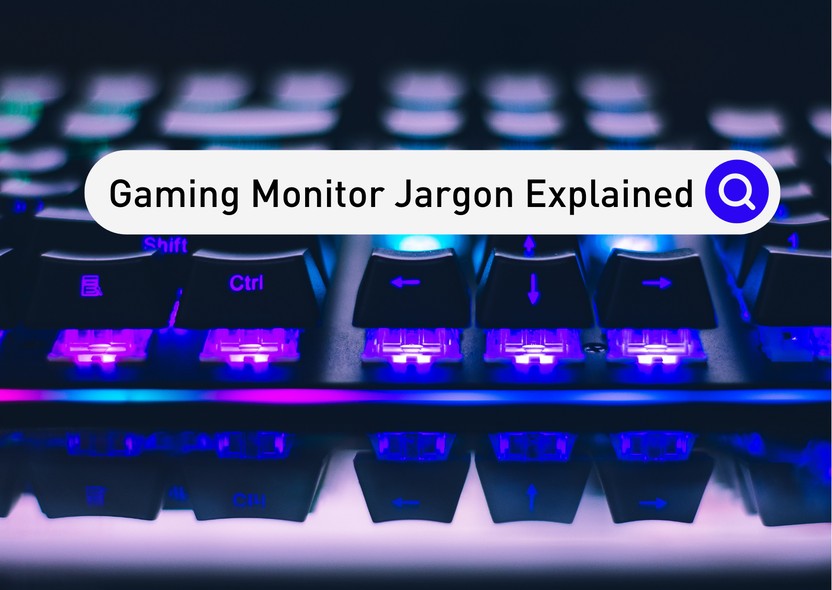Newsroom

16.03.2022
5 Gaming Monitor Jargon Explained
Lost in googling all the technical specs? We have put together a simple guide explaining some of the gaming monitor jargon to help you #findyourmonitor
If you are new to gaming, finding the best monitor for yourself can be difficult, especially when there are so many options to choose from! And understanding all the technical aspects is crucial. So, whether you are a newbie or rocking an older display while looking for an upgrade, you need to get familiar or up to date with the latest trends. To make your decision easier and help you #findyourmonitor, we have explained some of the most important gaming monitor jargon you’re bound to come across when investigating the market.
Resolution and Size: The first thing most of us look at when searching for any monitor is the display resolution and size. These are the visual dimensions of a display and the number of pixels. Is the more the better then? Visual detail can be a necessity in modern games and a higher resolution allows for sharper details and better overall clarity. Good gaming monitors tend to be 1080p (Full HD), 1440p (QHD/2K) or 2160p (UHD/4K) although it may be natural to immediately search for a UHD screen - it is important to consider your hardware limitations when making the final decision. The best screens (4K/ultra-widescreen) need the best graphics cards to reach their full potential.
Our Tip: 4K - Red Eagle G4380UHSU
Refresh Rate: Refresh rates are measured in Hertz (Hz) and indicate how many frames per second can be displayed on the screen. You’ll find most gaming monitors on the market today are 75Hz, 144Hz ~165Hz or 240Hz. Here the choice is simple - moving to 144~165Hz makes the biggest difference, above 165Hz is an option when you play First-Person-Shooter games (like Counter-Strike & Call of Duty) or when you are into competitive gaming. For occasional gaming, a 75Hz monitor with Adaptive Sync enabled is a viable choice.
Our tip: 240Hz - Gold Phoenix GB2590HSU and 165Hz – Red Eagle GB2770QSU
Panel technology: TN (twisted nematic) VA (vertical alignment) and IPS (in-plane switching) technology are the panel names you will encounter when looking for a gaming monitor. The names relate to the alignment of molecules within the LCD (liquid crystal display) and how they change when voltage is applied. All LCD monitors change the alignment of these molecules to work, but the way they do so can drastically affect the image and response time. Until some time ago TN panels were considered the obvious choice for gaming monitors as they would guarantee fast response times. However today VA and IPS panels support impressive response times. VA panels offer the best contrast ratios resulting in darker blacks and are used in curved models, whereas fast-IPS panels boast natural, highly accurate colour reproduction with a fast response time. The choice is yours, based on your gaming needs. Today iiyama incorporates mainly FLC-IPS, which is capable not only of delivering that colour depth and contrast ratio (important for seeing into the shadows) but can achieve less than 0.5ms response times. Combine that with 165Hz and you have a killer display for your rig.
Our Tip: VA curved - Red Eagle GB3467WQSU and Fast IPS - Red Eagle GB2770QSU
Response Time: This is one of the only times a lower number is better, spec-wise. Response time is basically how quickly the monitor can have a pixel change from fully active (white) to fully inactive (black), while refresh rate is how many times per second the panel can redraw the image. Pixel response time is measured in milliseconds (ms) and is crucial for smooth, non-blurred movement. When Motion Picture Response Time (MPRT) is shown the monitor supports a system reducing the noticeable movement of a pixel called blur. GTG response time is the lowest average time before pixel changes from one to another position. Conclusion: Nowadays our gaming monitors are fast enough and have features on board to reduce the noticeable blur to a minimum.
Our Tip: 0.5 ms - Red Eagle GB2770QSU
Adaptive Sync: This feature is a method for syncing up your graphics processor with your screen’s refresh rate. It eliminates the tearing and stuttering that may occur due to your GPU not consistently pushing out the same number of frames when you are playing. Gaming monitors by iiyama come with Adaptive Sync and are compatible with AMD FreeSync and Nvidia G-Sync. While this is extremely useful in gaming screens, it’s worth pointing out there are different levels of Adaptive-Sync compatibility
- AMD FreeSync – guarantees tear-free experience and low latency.
- AMD FreeSync Premium – all the above plus the screens are sure to have a refresh rate of over 120Hz and come with LFR (Low Frame Rate) compensation.
- AMD FreeSync Premium Pro – Besides a high refresh rate and LFR, FreeSync Premium Pro also supports HDR without huge latency increases and meticulous colour and luminance certification. It needs specific support built into each game for the HDR features. So, make sure to have a look at the list of games that support FreeSync Premium Pro on AMD’s website.
- Supports Nvidia G-Sync technology.
To sum it up, the best gaming monitors are the ones that truly show off what you and your PC are capable of. If you want to make the most of your high-performance CPU and graphics card, then a quality monitor is vital. And if becoming the next e-sports star is not on your 2022 checklist, you might as well do with a good mid-range screen.
For more #monitors4gamers, please visit: www.gmaster.iiyama.com